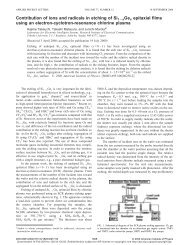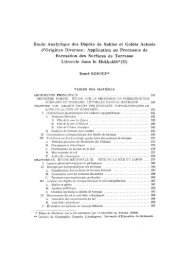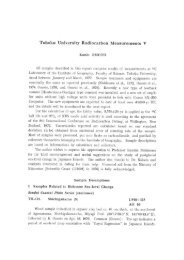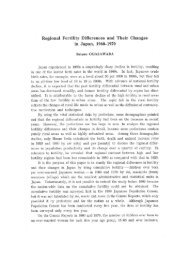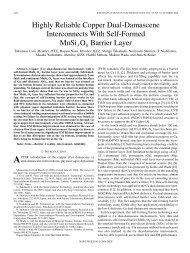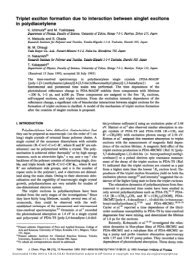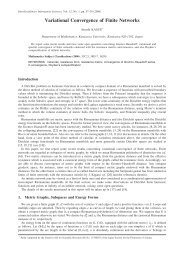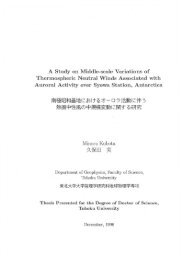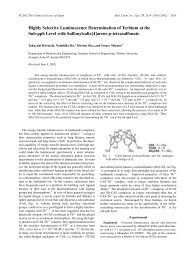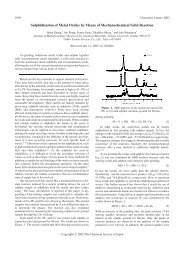Magnetically Retrievable Palladium/Maghemite Nanocomposite ...
Magnetically Retrievable Palladium/Maghemite Nanocomposite ...
Magnetically Retrievable Palladium/Maghemite Nanocomposite ...
Create successful ePaper yourself
Turn your PDF publications into a flip-book with our unique Google optimized e-Paper software.
922 Chemistry Letters Vol.37, No.9 (2008)<br />
<strong>Magnetically</strong> <strong>Retrievable</strong> <strong>Palladium</strong>/<strong>Maghemite</strong> <strong>Nanocomposite</strong> Catalysts<br />
Prepared by Sonochemical Reduction Method<br />
Yoshiteru Mizukoshi, 1 Kazuhisa Sato, 1 Toyohiko J. Konno, 1 Naoya Masahashi, 1 and Shuji Tanabe 2<br />
1 Institute for Materials Research, Tohoku University, 2-1-1 Katahira, Aoba-ku, Sendai 980-8577<br />
2 Graduate School of Science and Technology, Nagasaki University, 1-14 Bunkyo-machi, Nagasaki 852-8521<br />
(Received June 6, 2008; CL-080571; E-mail: mizukosi@imr.tohoku.ac.jp)<br />
<strong>Nanocomposite</strong> catalysts, consisting of Pd and magnetic<br />
maghemite, prepared by sonochemical reduction method<br />
showed high catalytic activities for the reduction of nitrobenzene.<br />
The used catalysts could be readily retrieved by magnets<br />
and be employed for further repetitive tests and verified the<br />
durability of the catalytic performance.<br />
The demands of noble metals, which are indispensable for<br />
IT industries and environmental protections such as automobile<br />
catalysts, have been extensively increasing. In uses of these<br />
noble metals, it is important to develop sustainable processes<br />
lightening the burdens on the environment.<br />
It is a general strategy to fabricate nanosized noble metals<br />
to enhance the catalytic activities. The fatal drawback of the<br />
nanoparticles is the difficulty in retrieving them from the reaction<br />
system. Further, remaining nanoparticles in the reaction system<br />
contaminate the reaction products. From the view point of<br />
recycle of noble metals, it is necessary to establish the effective<br />
methodology for retrieving the noble metal as reusable catalysts.<br />
In this study, we demonstrate the magnetically retrievable<br />
novel nanocatalysts consisting of Pd and magnetic maghemite<br />
( -Fe2O3) prepared by sonochemical reduction method, and<br />
the catalytic activities were evaluated by a reduction of nitrobenzene<br />
(NB). Further, the catalysts were retrieved by a neodymium<br />
magnet, and its activities were repeatedly evaluated to assess the<br />
durability. Recently, some researches focusing on ‘‘the magnetically<br />
retrievable heterogeneous catalysts’’ have been reported. 1<br />
Unlike conventional methods such as impregnation, the sonochemical<br />
method can reduce noble metal ions and concurrently<br />
immobilize the formed nanoparticles on the surface of supports<br />
without rising temperatures. 2<br />
An aqueous solution containing 0.5 mM of Na2PdCl4, -<br />
Fe2O3 nanoparticles (NanoTekÔ, C. I. Kasei) and poly(ethylene<br />
glycol) monostearate (PEG-MS, n 40) was purged by Ar prior<br />
to sonication. In the sonochemical reduction, PEG-MS is the<br />
precursor of the reducing agents. 3 The weight ratio of Pd to<br />
-Fe2O3 was 1/5, 1/10, and 1/20. The sample solution was<br />
sonicated in a closed glass vessel with 200 kHz and 6 W cm 2<br />
by a multiwave ultrasound generator (Kaijo TA-4021) with a<br />
PZT oscillator (Kaijo type 4611). The details of the sonication<br />
setup were described in previous papers. 4<br />
When the sample solution was sonicated, the color of the<br />
solution was changed from reddish-brown originating from pure<br />
-Fe2O3 to dark brown, indicating formation of Pd nanoparticles<br />
5 by the reduction of Pd ions. After 15 min of sonication,<br />
the sample solution was separated into magnetic and nonmagnetic<br />
fractions by a neodymium magnet.<br />
The magnetic fractions were redispersed in pure water, and<br />
the dispersion was dropped on a collodion-covered copper mesh<br />
and then dried for TEM specimens. The morphologies of the<br />
magnetic fractions were analyzed by a scanning-transmission<br />
electron microscope (STEM), FEI Titan 80–300 operated at<br />
300 kV, which is equipped with a high-angle annular dark field<br />
detector (HAADF). The image of the obtained Pd/ -Fe2O3<br />
nanocomposite catalysts is shown in Figure 1, wherein the<br />
contrast of HAADF images is proportional to square of the<br />
atomic numbers. The atomic numbers of Pd and Fe are 42 and<br />
26, respectively, so that it is concluded that the smaller particles<br />
with bright contrast are Pd nanoparticles, and the larger particles<br />
with dark contrasts are -Fe2O3. The distributions of the constituent<br />
elements were analyzed by EDX mappings, revealing that<br />
the Pd nanoparticles are immobilized on the surface of -Fe2O3<br />
and that the average diameter of Pd is 3.8 nm. The average diameters<br />
of the immobilized Pd nanoparticles prepared by different<br />
conditions are tabulated in Table 1. The amounts of immobilized<br />
Pd derived from the differences between the fed and the remaining<br />
Pd in nonmagnetic fraction determined by a colorimetric<br />
method 6 are included in the table. We proposed the mechanism<br />
for the sonochemical immobilization of noble metal nanoparticles<br />
such that noble metal ions were reduced in the bulk solution<br />
to form the nuclei of the particles, and then they were immobilized<br />
on the surface of the supports. 7 Significant dependency<br />
of the sizes and amounts of Pd on the amounts of -Fe2O3 is<br />
not observed, which is consistent with the proposed mechanism.<br />
The catalytic activities of the nanocatalysts were investigated<br />
by the reduction of NB under the reaction condition reported<br />
by Lu et al. 8 A 0.01-g portion of the sonochemically prepared<br />
catalysts was added to 30 mL of ethanol containing 0.3 mmol<br />
of NB. The reduction of NB was conducted at 25 C under<br />
1 atm of hydrogen. The solution was periodically sampled, and<br />
trace of the magnetic fraction was removed from the solution<br />
using a neodymium magnet prior to the HPLC analyses. The<br />
progress of the reaction was monitored by the amounts of formed<br />
aniline (AN) and consumed NB measured by HPLC. The fed NB<br />
50 nm<br />
Copyright Ó 2008 The Chemical Society of Japan<br />
Pd-L<br />
Fe-K<br />
Fe-L<br />
O-K<br />
Figure 1. HAADF-STEM image of un-used Pd/ -Fe2O3<br />
nanocomposite catalysts and corresponding EDX mappings.
Chemistry Letters Vol.37, No.9 (2008) 923<br />
Table 1. Sonochemically prepared Pd/ -Fe2O3 nanocomposite<br />
catalysts<br />
(a) (b) (c)<br />
-Fe2O3/mg 13.3 26.6 53.2<br />
Pd/ -Fe2O3 (w/w) a 0.2 0.1 0.05<br />
Immobilized Pd/mg 2.53 2.46 2.31<br />
(95.40%) (92.40%) (86.96%)<br />
Pd size/nm 4:9 0:9 4:00:8 3:80:9 TOF/h 1b 55:3 3:7 70:531:7 301 94:3<br />
a Fed Pd was 0.5 mM (2.66 mg) in each sample. b Average of<br />
four times of repetitive tests.<br />
%<br />
110<br />
100<br />
90<br />
80<br />
70<br />
60<br />
50<br />
NB conversion (left axis)<br />
AN selectivity (left axis)<br />
TOF (right axis)<br />
1 2 3 4<br />
Repetitive time<br />
was completely consumed within 30 min of the reaction time.<br />
In response, AN was formed and the yield was reached the<br />
maximum at the 30 min of reaction time. The change in the<br />
color of the reaction solution was not observed during 60 min<br />
of the reactions, indicating that detachments of Pd nanoparticles<br />
did not occur. After 60 min, the nanocatalysts were retrieved by<br />
a neodymium magnet and supplied for the next measurements<br />
after rinsing with ethanol.<br />
The changes in NB conversion (consumed NB(mol)/fed<br />
NB(mol)), AN selectivity (formed AN(mol)/consumed<br />
NB(mol)), and TOF of AN formation (formed AN(mol)/<br />
immobilized Pd(mol)/reaction time (h)) in the four times of repetitive<br />
uses are displayed in Figure 2. 9 On an average, NB conversion<br />
and AN selectivity were 100 and 87%, respectively.<br />
A spread of TOF as found in Figure 2 is probably due to the state<br />
of the dispersion of the catalysts. The maximum TOF was<br />
429.6 h 1 , and the average of the four repetitive evaluations<br />
was 301.2 h 1 . This result is not inferior to the previously reported<br />
value, e.g., the activity of Pd/Ni catalysts by Nagaveni et al. 10<br />
Furthermore, the present nanocatalysts exhibits high TOF<br />
400<br />
300<br />
200<br />
100<br />
0<br />
TOF / h -1<br />
Figure 2. Change in the catalytic activity during the repetitive<br />
uses.<br />
in spite of repetitive uses, and it is advantageous for practical<br />
usages and saving Pd. In addition, magnetic retrieving facilitates<br />
the effective purification of the reaction products. STEM observation<br />
of the catalysts after four times repetitive evaluations<br />
showed no distinct changes in the sizes of the immobilized<br />
Pd nanoparticles between before and after evaluation, which is<br />
consistent with the maintenance of the initial catalytic activities.<br />
TOFs of the catalysts with different compositions are listed in<br />
Table 1, wherein the TOFs are the average of four repetitive<br />
uses. Faint correlation between TOFs and the sizes of the immobilized<br />
Pd nanoparticles is recognized, and it suggests that the<br />
catalytic activity of the present catalysts depend not only on<br />
the sizes of the Pd but on carrier effect coming from the amount<br />
of -Fe2O3 supports.<br />
In conclusion, Pd/ -Fe2O3 nanocomposite catalysts prepared<br />
by the sonochemical reduction method exhibit excellent<br />
catalytic activities for the reduction of NB and high durability<br />
for repetitive uses.<br />
This study was financially supported by Japan Science<br />
and Technology Agency. The authors thank Ms. Y. Matsuda<br />
(IMR, Tohoku Univ.) for her helpful assistance in laboratory<br />
works.<br />
References and Notes<br />
1 a) D. K. Yi, S. S. Lee, J. Y. Ying, Chem. Mater. 2006, 18,<br />
2459. b) Z. Wang, P. Xiao, B. Shen, N. He, Colloids Surf.,<br />
A 2006, 276, 116. c) D. Guin, B. Baruwati, S. V. Manorama,<br />
Org. Lett. 2007, 9, 1419.<br />
2 K. Okitsu, S. Nagaoka, S. Tanabe, H. Matsumoto, Y.<br />
Mizukoshi, Y. Nagata, Chem. Lett. 1999, 271.<br />
3 Y. Mizukoshi, E. Takagi, H. Okuno, R. Oshima, Y. Maeda,<br />
Y. Nagata, Ultrason. Sonochem. 2001, 8, 1.<br />
4 For example, Y. Mizukoshi, R. Oshima, Y. Maeda, Y.<br />
Nagata, Langmuir 1999, 15, 2733.<br />
5 J. A. Creighton, D. G. Eadon, J. Chem. Soc., Faraday Trans.<br />
1991, 87, 3881.<br />
6 K. Okitsu, H. Bandow, Y. Maeda, Y. Nagata, Chem. Mater.<br />
1996, 8, 315.<br />
7 Y. Mizukoshi, Y. Tsuru, A. Tominaga, S. Seino, N.<br />
Masahashi, S. Tanabe, T. A. Yamamoto, Ultrason.<br />
Sonochem. 2008, 15, 875.<br />
8 P. Lu, T. Teranishi, K. Asakura, M. Miyake, N. Toshima,<br />
J. Phys. Chem. B 1999, 103, 9673.<br />
9 In the calculations of catalytic activities, adsorbed nitrobenzene<br />
on catalyst surface and reaction vessel (7% of fed<br />
amount), which was determined in a blank test in the<br />
absence of hydrogen, was subtracted from the consumption<br />
of nitrobenzene.<br />
10 K. Nagaveni, A. Gayen, G. N. Subbanna, M. S. Hegde,<br />
J. Mater. Chem. 2002, 12, 3147.<br />
Published on the web (Advance View) July 26, 2008; doi:10.1246/cl.2008.922






